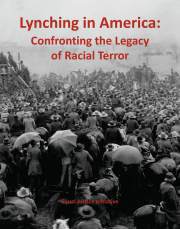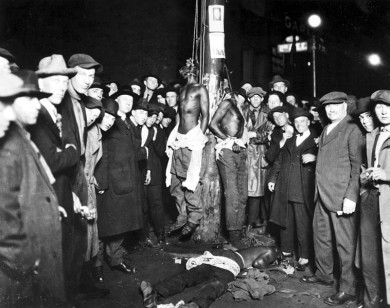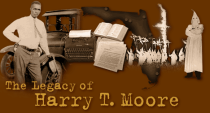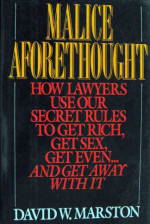Lynching in the United States - Civil Rights page
Lynching in the United States
Wikipedia
Lynching, the practice of killing people by extrajudicial mob action, occurred in the United States chiefly from the late 18th century through the 1960s. Lynchings took
place most frequently in the South from 1890 to the 1920s, with a peak in the annual toll in 1892.
It is associated with re-imposition of White supremacy in the South after the Civil War. The granting of civil rights to freedmen in the Reconstruction era (1865–77)
aroused anxieties among white citizens, who came to blame African Americans for their own wartime hardship, economic loss, and forfeiture of social privilege. Black Americans, and Whites active in
the pursuit of equal rights, were frequently lynched in the South during Reconstruction. Lynchings reached a peak in the late 19th and early 20th centuries, when Southern states changed their
constitutions and electoral rules to disfranchise most blacks and many poor whites, and, having regained political power, enacted a series of segregation and Jim Crow laws to reestablish White
supremacy. Notable lynchings of civil rights workers during the 1960s in Mississippi contributed to galvanizing public support for the Civil Rights Movement and civil rights legislation.
The Tuskegee Institute has recorded 3,446 blacks and 1,297 whites were lynched between 1882 and 1968. Southern states created new constitutions between 1890 and 1910,
with provisions that effectively disfranchised most blacks, as well as many poor whites. People who did not vote were excluded from serving on juries, and most blacks were shut out of the official
political system. Read more
Strange Fruit Wikipedia
Abel Meeropol NPR
"Strange Fruit" is a song performed most famously by Billie Holiday, who first sang and recorded it in 1939. Written by teacher Abel Meeropol as a poem and published in 1937, it protested American racism, particularly the lynching of African Americans. Such lynchings had reached a peak in the South at the turn of the century, but continued there and in other regions of the United States.[2][3] Meeropol set it to music and, with his wife and the singer Laura Duncan, performed it as a protest song in New York venues in the late 1930s, including Madison Square Garden.
The song continues to be covered by numerous artists, as well as inspiring novels, other poems and other creative works. In 1978, Holiday's version of the song was inducted into the Grammy Hall of Fame.[4] It was also included in the list of Songs of the Century, by the Recording Industry of America and the National Endowment for the Arts. Read more
Without Sanctuary:
Lynching Photography in America
James Allen, Author
These images make the past present. They refute the notion that photographs of charged historical subjects lose their power, softening and becoming increasingly aesthetic
with time. These images are not going softly into any artistic realm. Instead they send shock waves through the brain, implicating ever larger chunks of American society and in many ways reaching up
to the present. They give one a deeper and far sadder understanding of what it has meant to be white and to be black in America. And what it still means. -- New York Times. Read more
The Legendary Ida B Wells/ Her Great Passion
For Justice Anti Lynching Crusader
Ida B. Wells
Wikipedia
Ida Bell Wells-Barnett (July 16, 1862 – March 25, 1931) was an African-American journalist, newspaper editor, suffragist, sociologist, and an early leader in the civil rights movement. She documented lynching in the United States, showing that it was often used as a way to control or punish blacks who competed with whites, rather than being based in criminal acts by blacks, as was usually claimed by white mobs.[1] She was active in women's rights and the women's suffrage movement, establishing several notable women's organizations. Wells was a skilled and persuasive rhetorician, and traveled internationally on lecture tours.[2] Read more
Florida Lynched More Black People Per Capita Than Any Other State
Broward Palm Beach New Times, February 11, 2015
"Reuben Stacy, a 37-year-old black man, hangs from a tree on Old Davie Road in Fort Lauderdale, blood trickling down his body and dripping off his toes. Behind him, a white girl, about 7 years old, looks on, a strange smile on her face as she takes in the sight of the "strange fruit" her elders had just created that hot day in July 1935."
Lynchings in Florida? It was a problem here, too
The Gainesville Sun, Gainesville.com, September 3, 2005
Marion County led Florida in the number of lynchings, according to University of Florida professor Jack Davis is a scholar of race relations in the South.
Lynching in America: Confronting the legacy of Racial Terror
Lynching in America: Confronting the Legacy of Racial Terror documents EJI’s multi-year investigation into lynching in twelve Southern states during the period between Reconstruction and World War II. EJI researchers documented 3959 racial terror lynchings of African Americans in Alabama, Arkansas, Florida, Georgia, Kentucky, Louisiana, Mississippi, North Carolina, South Carolina, Tennessee, Texas, and Virginia between 1877 and 1950 – at least 700 more lynchings of black people in these states than previously reported in the most comprehensive work done on lynching to date. Read more
EJI Report Summary: Lynching in America: Confronting the Legacy of Racial Terror. New York Times: History of Lynchings in the South Documents Nearly 4,000 Names. Supplement - Lynchings of African Americans by County. (30 lynchings in Marion County, Florida)
The 1920 Duluth, Minnesota Lynchings
- The Duluth Lynchings, Minnesota Historical Society
- Teaching Tolerance magazine: It Happened Here
1920 Duluth lynchings
Wikipedia
The 1920 Duluth Lynchings occurred on June 15, 1920, when three black circus workers were attacked and lynched by a mob in Duluth, Minnesota. Rumors had circulated among
the mob that six African Americans had raped a teenage girl. A physician's examination subsequently found no evidence of rape or assault.
The killings shocked the country, particularly for their having occurred in the northern United States, although four earlier lynchings had occurred in Minnesota. In
2003, the city of Duluth erected a memorial to the murdered workers. Read more
The Lynching of Jesse Washington: Waco, Texas - 1916
Lynching of Jesse Washington
Wikipedia
The Jesse Washington lynching, or Waco Horror, was the disfigurement, torture, and lynching of a 17-year old African American farmhand from Waco, Texas, United States, on
May 15, 1916. Washington's killing occurred after he was found guilty in a one-hour long trial for the rape and murder of a wealthy 53-year-old woman. Sources conflict as to whether Washington's
guilt was ascertained at the trial; although he signed a confession, which was published widely in several local newspapers, Washington was by all accounts illiterate. Some sources indicate that
Washington was mentally handicapped.
The incident's modern infamy is in large part due to the numerous extant photographs of the youth's mutilated body, including postcards which were marketed for commercial
purposes.
"Topic of the Times", New York Times, May 17, 1916. Retrieved 2008-12-26. "[I]n no other land even pretending to be civilized could a man be burned to death in the streets of a considerable city amid the savage exultation of its inhabitants." Read more
NY Times, Lynching of Jesse Washington.p[...]
Adobe Acrobat document [98.5 KB]
Lynching of Laura & Lawrence Nelson: Oklahoma, 1911
Lynching of Laura and Lawrence Nelson
Wikipedia
Laura and Lawrence Nelson were African Americans who were lynched in Okemah, Oklahoma, on May 25, 1911.
Laura, her husband, their 15-year-old son Lawrence, and (by some accounts) their baby, were taken into custody after Lawrence shot and killed George Loney, Okemah's
deputy sheriff. Loney and a posse had arrived at the Nelsons' home to investigate the theft of a cow. Laura's husband pleaded guilty to the theft and was sent to the state prison. In an effort to
save her son, Laura said she had fired the fatal shot. Both she and Lawrence were arrested; the son was taken to the local jail and Laura to a cell in the county courthouse.
Three weeks later a mob of 40 armed men arrived to kidnap the mother and son. They tied up the guard and dragged off the mother and son. Laura was raped, according to
some reports, and both were hanged from a bridge over the North Canadian River. Hundreds of sightseers gathered on the bridge the following morning, and photographs of the hanging bodies were
sold as postcards. The killers were never identified. The folk singer Woody Guthrie, whose father as a young man attended the lynching and later belonged to the Ku Klux Klan, wrote about the event in
three songs.
The Nelsons were among at least 4,743 people lynched in the United States between 1882 and 1968, 3,446 of them black, 154 of them women, 73 percent of them in the
South. Read more
James Cameron: Lynching Survivor, Activist
James Cameron: Lynching Survivor, Activist Wikipedia
James Cameron (February 23, 1914 – June 11, 2006), not to be confused with the film director of the same name, was an American civil rights activist. In the 1940s, he
founded three chapters of the National Association for the Advancement of Colored People (NAACP). He also served as Indiana's State Director of the Office of Civil Liberties for eight years during
early integration. After moving to Wisconsin, in 1988 he founded America's Black Holocaust Museum in Milwaukee. At his death, he was the only known survivor of a
lynching attempt. more
_____________________________________________________________
Life Stories:
He Survived a Lynching, Now He Won't Let Us Forget
Chicago Reader.com
Milwaukee
By Frederick H. Lowe
May 30, 2002
The image is one most Americans would prefer to forget: Two black men, beaten and bloodied, hang from an elm tree in the Grant County Courthouse Square. A white crowd mills around beneath them, and in the foreground a man glares at the camera, pointing back at one of the bodies. A photographer snapped the picture on August 7, 1930, the night 18-year-old Thomas Shipp and 19-year-old Abram Smith were lynched in Marion, Indiana.
James Cameron still remembers that night--he was the third man the crowd wanted dead. He could hear the people chanting outside his second-floor jail cell: "We want Cameron! We want Cameron!" Led by a Klansman carrying a Thompson submachine gun, they beat the 16-year-old and dragged him from his cell, punching and kicking him as they pushed him down the stairs.
Fifteen thousand people were gathered outside. Jacob Campbell, sheriff of Grant County, had threatened to shoot into the crowd if it didn't disperse, but women and children stood in the front ranks, calling his bluff. Hooded Klansmen and Marion police cleared a path through the crowd for Cameron, and when he reached the elm tree a noose was fastened around his neck. Cameron prayed silently, waiting to die. The photographer captured another image of the smiling and festive crowd.
But then they all fell silent. Cameron heard a woman's voice: "Take this boy back. He had nothing to do with the killing and the rape." The noose was removed from his neck, the crowd began to break up, and Cameron staggered back to the jail. Read more
America's Black Holocaust Museum
America's Black Holocaust Museum Wikipedia
America's Black Holocaust Museum located in Milwaukee, Wisconsin was the only memorial dedicated specifically to the victims of the enslavement of Africans in the United
States. It was founded by James Cameron, America's last living survivor of a lynching. Cameron died in 2006; in 2008, the museum's board of directors announced that the museum would be closed
temporarily because of financial problems. It has not re-opened since.













































































































































